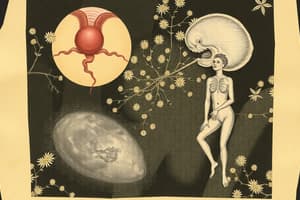Podcast
Questions and Answers
What occurs during ovulation?
What occurs during ovulation?
- The egg is released from the ovary. (correct)
- The blastocyst forms two layers.
- The sperm penetrates the egg.
- The zygote implants in the uterus.
Which term describes the single cell formed after fertilization?
Which term describes the single cell formed after fertilization?
- Zygote (correct)
- Germinal
- Embryo
- Blastocyst
During which stage of prenatal development are major organs formed?
During which stage of prenatal development are major organs formed?
- Germinal stage
- Fetal stage
- Post-natal stage
- Embryonic stage (correct)
What defines a pre-term birth?
What defines a pre-term birth?
What hormone is produced by the pituitary gland that supports growth in the body?
What hormone is produced by the pituitary gland that supports growth in the body?
Which factor is associated with complications during pregnancy?
Which factor is associated with complications during pregnancy?
What is the primary characteristic of the fetal stage?
What is the primary characteristic of the fetal stage?
Which gland is primarily responsible for regulating metabolism through the secretion of thyroxine?
Which gland is primarily responsible for regulating metabolism through the secretion of thyroxine?
Which part of the nervous system is responsible for transmitting sensory and motor signals to and from the central nervous system?
Which part of the nervous system is responsible for transmitting sensory and motor signals to and from the central nervous system?
Which prenatal factor can potentially affect fetal development?
Which prenatal factor can potentially affect fetal development?
How long does the prenatal stage typically last?
How long does the prenatal stage typically last?
What function does the parasympathetic nervous system primarily support?
What function does the parasympathetic nervous system primarily support?
Which of the following best describes synaptogenesis?
Which of the following best describes synaptogenesis?
What aspect of brain development is primarily associated with the left hemisphere?
What aspect of brain development is primarily associated with the left hemisphere?
What developmental change indicates a decrease in mental processing and coordination in late adulthood?
What developmental change indicates a decrease in mental processing and coordination in late adulthood?
Which reflex is associated with locating a food source during infancy?
Which reflex is associated with locating a food source during infancy?
What significant physical development occurs during adolescence?
What significant physical development occurs during adolescence?
At what age does peak physical capability typically occur?
At what age does peak physical capability typically occur?
Which of the following is not considered a psychosocial opportunity?
Which of the following is not considered a psychosocial opportunity?
During which life stage do girls typically experience growth spurts?
During which life stage do girls typically experience growth spurts?
Which of the following best describes the effects of parental contributions on children?
Which of the following best describes the effects of parental contributions on children?
What is the role of nutrition in health according to the content?
What is the role of nutrition in health according to the content?
What psychological challenge do adolescents often grapple with?
What psychological challenge do adolescents often grapple with?
What physical characteristic is associated with middle adulthood in women?
What physical characteristic is associated with middle adulthood in women?
Study Notes
Beginning of Life
- Ovulation involves the release of an egg from the ovary, guided by fimbriae into the fallopian tubes.
- Fertilization occurs when a sperm cell penetrates an egg within the fallopian tube.
- A zygote is created when an egg and sperm cell merge into a single cell.
- A blastocyst is a hollow sphere of cells differentiated into three layers: endoderm (digestive and respiratory systems), ectoderm (skin and nervous system), and mesoderm (muscle and skeletal systems).
Prenatal Stage
- The prenatal stage refers to development from conception to birth, usually lasting around 40 weeks.
- Pre-term refers to birth before 37 weeks of gestation.
- Post-term indicates birth after 42 weeks of gestation.
Stages of Prenatal Development
- Germinal stage (fertilization to 2 weeks): The zygote travels to the uterus and implants itself for protection.
- Embryonic stage (2 weeks to 8 weeks): Formation of essential organs begins.
- Fetal stage (8 weeks to birth): Development of organs continues, and sensory functions emerge.
Factors Affecting Prenatal Development
- Prenatal development encompasses growth in the womb from conception to birth.
- Pregnancy is the span of time a woman carries a developing baby, typically about nine months.
- Pre-natal care is crucial for the health of the mother and fetus.
- Miscarriage is the loss of a baby before the 20th week.
- Ectopic pregnancy occurs when a fertilized egg implants outside the uterus.
- Pregnancy complications can arise due to rapid hormonal changes.
- Bleeding indicates heavier blood loss, while spotting involves small amounts.
- Maternal context includes the mother's readiness and biological factors.
- Medical concerns relate to medications taken by the mother affecting fetal development.
- Environmental factors, including social support, impact pregnancy quality.
- The quality of sperm can also influence prenatal outcomes.
The Body Systems
- The endocrine system regulates hormone production, affecting short- and long-term health.
- Major glands include pituitary (growth hormones), thyroid (brain development), adrenal (stress response), and gonads (sex hormones).
- The nervous system manages bodily functions and impacts behavior.
- The central nervous system consists of the brain and spinal cord; the peripheral nervous system connects the CNS to the body.
- The somatic nervous system handles voluntary actions, while the autonomic nervous system regulates involuntary functions, divided into sympathetic (stress response) and parasympathetic (relaxed state).
- Brain development involves synaptogenesis (neural connections) and lateralization (hemisphere specialization).
- Adolescent brain development centers on the prefrontal lobe, crucial for impulse control and decision-making.
- Late adulthood sees a decline in brain cells impacting processing, coordination, memory, and health.
Physical Development Across Stages
- Infancy includes reflexive responses essential for survival (e.g., sucking, grasping, rooting).
- Childhood sees improved motor function and coordination along with sensory advancements.
- Adolescence features growth spurts, with boys developing around 12 and girls around 10, accompanied by hormonal changes and identity challenges.
- Adulthood is characterized by peak physical abilities in the early 20s; physical decline begins in the 60s, with women experiencing menopause and men facing reduced fertility.
Parental Contributions
- Parental attitude and knowledge significantly influence child development.
- Cultural influences shape parenting styles and expectations.
- Socioeconomic barriers can limit access to resources and nurturing.
- Educational practices impact child learning and development.
Psychosocial Opportunities
- Social interaction fosters confidence through positive relationships.
- Emotional well-being is enhanced by social support, promoting security and motivation.
- Managing stress effectively contributes to overall health.
Physical Environment
- Non-social aspects, such as living conditions and available resources, affect development.
Nutritional Knowledge and Practices
- Overall health signifies mental and physical well-being, emphasizing disease prevention and coping with situations.
- Nutrition involves utilizing food for tissue maintenance and repair, categorized as:
- Go: Carbohydrates (e.g., rice, bread)
- Grow: Proteins (e.g., meat, eggs)
- Glow: Vitamins and minerals (e.g., milk)
Research Integration
- Studies indicate the effects of yoga and physical exercise on children's physical, cognitive, and emotional development, leading to increased self-esteem and overall health.
Studying That Suits You
Use AI to generate personalized quizzes and flashcards to suit your learning preferences.
Related Documents
Description
This quiz explores the crucial stages of prenatal development, from ovulation and fertilization to the different stages before birth. Learn about the formation of the zygote, blastocyst, and the various phases leading to a new life. Test your knowledge on key terms such as germinal, embryonic, and fetal stages.




